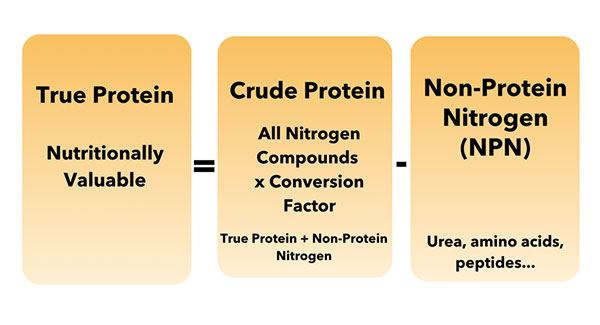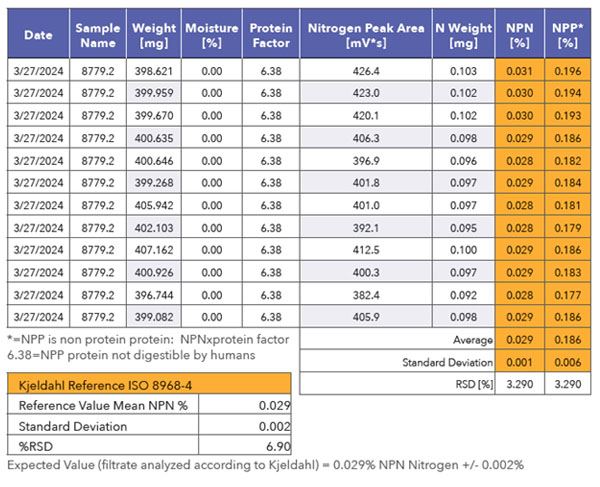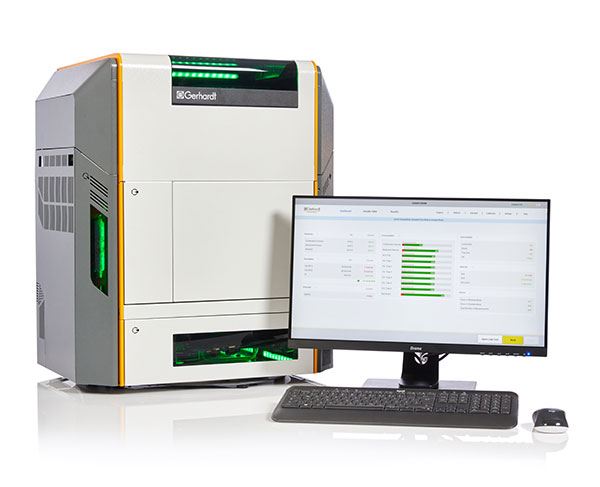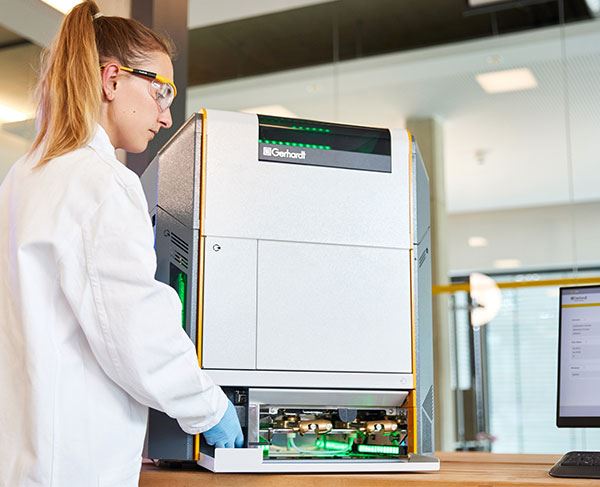Unlocking True Protein Content: Advantages of Dumas Over Kjeldahl in NPN Analysis
Dumas Method Application for Non-Protein Nitrogen (NPN) Analysis in Milk and Beyond
Milk and dairy products are vital in various sectors, including baby food, pharmaceuticals, and supplements, due to their high-quality proteins. These proteins are essential for human protein synthesis and tissue repair, and they offer diverse functional properties and nutritional benefits.
Crude milk proteins essentially consist of casein, whey proteins, and non-protein nitrogen (NPN). Non-protein nitrogen (NPN) refers to nitrogen-containing compounds present in biological samples that differ from true proteins. NPN is the component of the crude protein that cannot be processed by humans and is therefore distinguished from the true protein.
What is NPN?
NPN, or non-protein nitrogen, includes molecules such as urea, creatine, peptides, free amino acids, ammonia, and other nitrogenous compounds in a sample. These are components of the crude protein that humans or animals cannot process and, therefore, are not nutritionally valuable.
To accurately measure the true protein content in a sample, it's essential to account for both the true protein and the non-protein nitrogen (NPN) components. Crude protein is initially calculated based on the total nitrogen content in the sample, which includes nitrogen from both true proteins and NPN compounds like urea, creatine, and free amino acids.
Since NPN does not contribute to the actual nutritional value of the protein, subtracting the NPN from the crude protein value gives you the true protein content. This subtraction provides a more accurate reflection of the protein that can be utilized by humans or animals, ensuring that the reported protein content is nutritionally meaningful.

Why Measure NPN?
Measuring Non-Protein Nitrogen (NPN) plays a pivotal role in accurately assessing the nutritional value of food and feed products while also preventing adulteration. The infamous melamine scandal in China serves as a stark example of how adding NPN-rich substances can falsely inflate protein values, highlighting the importance of robust NPN analysis for product integrity and consumer safety.
Key Reasons for NPN Measurement:
Quality Control
- Ensure quality and detect contamination
Regulatory Compliance
- Protect consumer safety and ensure accurate nutritional labeling
Protein Content
- Accurately measure true protein content for protein that can be processed by humans or animals
Detect Adulteration
- Verify product authenticity and prevent fraud

Methods for NPN Analysis
Measuring NPN is challenging, and the Kjeldahl method remains the primary method for determining protein and non-protein content in food due to the low levels of NPN in most samples.
The Kjeldahl method involves several steps to convert nitrogen in the sample into 'crude protein.' The process starts with sample digestion using concentrated sulfuric acid, breaking down organic matter. The resulting ammonium sulfate is treated with sodium hydroxide to convert nitrogen into ammonia gas, which is then collected and titrated to determine nitrogen content used to calculate crude protein content.
However, 5-6% of milk’s nitrogen exists as non-protein nitrogen, conventionally counted as protein using the standard Kjeldahl method. The Kjeldahl method does not differentiate between NPN and true protein. This can lead to inaccuracies in determining the true protein content of milk and other samples.
Determining the NPN content and subtracting it from the crude protein content reveals the true protein value; however, the Kjeldahl method takes multiple hours to get these results. Due to the need for faster analysis, higher throughput, and the elimination of hazardous chemicals, there has been a shift towards adopting the Dumas method for protein analysis, even though it lacks established methods and norms for accounting for NPN.
The Dumas Method
The Dumas and Kjeldahl methods differ in principle but share the measurement of nitrogen content. The Dumas method, named after French chemist Jean-Baptiste Dumas, who developed it in the early 19th century, is based on sample combustion, which converts nitrogen-containing compounds into nitrogen gas.
In the Dumas method, a small sample is placed in a combustion chamber and heated to high temperatures, causing organic compounds to decompose and release gases, including nitrogen, which are then measured by a thermal conductivity detector (TCD).
The Dumas method is particularly useful for determining nitrogen content in organic compounds like proteins, making it relevant for studying and analyzing NPN proteins. By accurately measuring total nitrogen content, scientists can gain insights into the composition and quality of these proteins.
Our research demonstrates the application of the Dumas method in analyzing milk samples, effectively determining “true protein” by subtracting the non-protein nitrogen (NPN) as outlined in ISO 8968-4:2016 for protein content calculation. The Kjeldahl method was used as a reference method in the comparison. Notably, both the Dumas and the Kjeldahl methods yielded an expected NPN value of 0.029% non-protein nitrogen. However, the Dumas method offered a significantly improved RSD (relative standard deviation) of 3.28% vs 6.90% for the Kjeldahl method.

Advantages of the Dumas Method over the Kjeldahl Method
Utilizing the N-REALYZER instrument with the Dumas method offers notable advantages over the traditional Kjeldahl method.
1. Automation and efficiency: The Dumas method can be fully automated after sample preparation, allowing for rapid results more efficiently.
2. Higher throughput: The Dumas method offers increased throughput of 50% over Kjeldahl. The ability with the N-REALYZER to handle 100 samples, with results for each sample in under 5 minutes.
3. Improved Worker Safety and Sustainability: Unlike the Kjeldahl method, which uses hazardous chemicals, the Dumas method eliminates the need for these chemicals for increased safety and sustainability.
4. Ultimate Accuracy. An automated Dumas method has shown to have a much lower RSD than the Kjeldahl method.
By leveraging the advantages of the Dumas method, researchers and laboratories can streamline their protein analysis workflow, saving time, increasing productivity, and ensuring safety.
Conclusion
Accurate Non-Protein Nitrogen (NPN) analysis is critical not only for determining true protein content in milk products but also for ensuring the overall nutritional quality and safety of various food and feed products. As consumers and regulatory bodies increasingly demand transparency and accuracy in nutritional labeling, the need for precise protein analysis methods has never been more vital.
The Dumas method, with its significant advantages over traditional techniques like the Kjeldahl method, offers a faster, more efficient, and safer approach to nitrogen and protein analysis. This method’s ability to deliver highly accurate results makes it particularly valuable in diverse applications across the food and feed industries, from dairy to plant-based proteins and beyond.
While the Dumas method already offers considerable benefits, its broader adoption and integration into established standards will be essential for driving future advancements in protein analysis, ultimately supporting the industry's commitment to quality and safety.
As the only comprehensive protein experts offering both Dumas and Kjeldahl solutions, we are uniquely positioned to provide your laboratory with the best method for accurate protein analysis. Whether you require the speed and safety of the Dumas method or the established precision of the Kjeldahl method, our expertise ensures that your specific needs are met with the most suitable and reliable approach.


